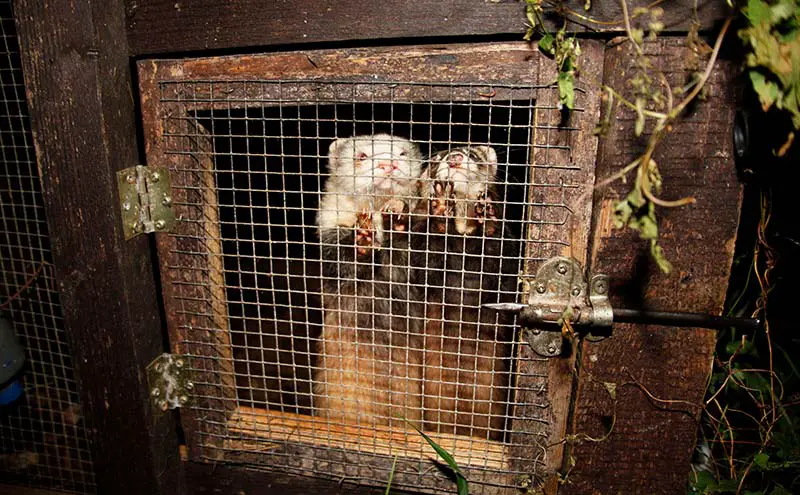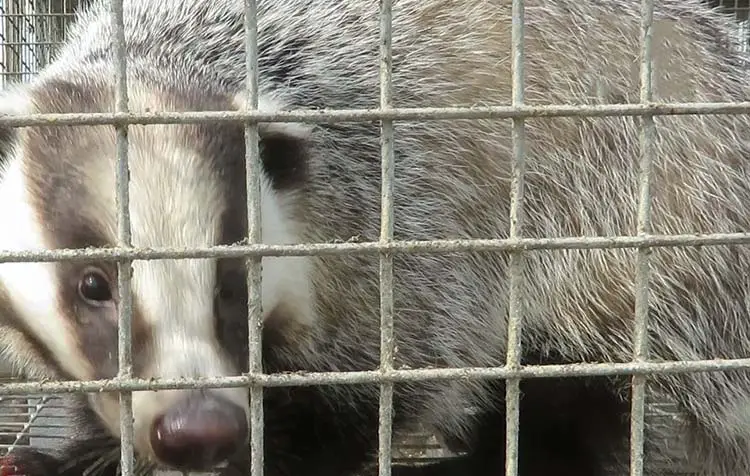Why do we buy products with fur - and how can we save fur animals? Questions about questions. Caps, coats, scarves peppered with the fur of other creatures - who wants to be beautiful, lets suffer, you might think. I used to have a jacket with fur myself - I just didn't know what suffering was behind it. With the knowledge, then came the change. I can hardly imagine that anyone would prefer clothes or other products with fur, if he or she is aware of the background of the fur industry.
In this post I want to give you just that and also discuss the question of whether fur products in 2020 are still contemporary and meaningful. Let's go!
What is fur anyway?
Fur is the flayed skin of animals, usually with densely standing hair, which is usually processed into clothing, its trim or accessories. Some animals are hunted, trapped and bred specifically for their production, others are considered pests. Cases also often arise as a by-product - for example, in the meat-producing Factory farming. Furs and fur goods were among the earliest trade goods - until the 17th century they were also only allowed to be worn by certain groups of people and estates in Europe.₁.
The European Union regulates the requirements for keeping and breeding fur animals - there is no general ban on the fur trade. A distinction is made, for example, between pet fur, farm animal fur and wild animal fur. The trade in pet fur, such as from cats or dogs, is prohibited in the EU. But farm animal fur and wild animal fur are usually a legal and very popular trade item. Some countries, such as Austria, Norway or the Netherlands, have therefore extended the European requirements and banned fur farms on a national level. In Germany, however, fur farms are still allowed, provided that the husbandry requirements are met.
What animals are killed for fur?

So the definition is clear. But which animals are actually tortured or killed for fur? Or to put it another way, which animals have to lose their lives for us to gain fur? Here are some examples:
- Minks
- Marten
- Foxes
- Dogs
- Cats
- Sheep
- Goats
- Hamster
- Rabbit
- Lynxes
- Weasel
- Squirrel
- Beaver
- Nutria
- Raccoons
- Coyotes
- Badgers
- Seals
- Chinchillas
- …
But the list is almost endless. Look at my post about Documentaries about factory farming. One recommendation from this is the Dominion film, which will also give you deeper insights into the fur industry.
Statistics on fur animals and the fur industry
To get a better idea of the extent of the fur trade and to get a specific motivation to change something about it, here's a handful more Facts and figures of the fur industry for you:
- Up to 229 animals have to die for one fur coat.₂ (100 cm length = 80 squirrels, 64 chinchillas, 20-28 minks, 38 rabbits, 8-10 foxes and 9 lynxes).
- 12,700,000 foxes were processed into fur worldwide in 2017. In the same period, 63,100,000 mink were also killed for fur products.
- 46.9 percent of the furs from the German fur industry come from breeding and farming. 37.6 percent are a product of the meat industry and 15.3 originate from pest control. Only 0.2 percent of the furs are due to hunting.
- In 2016, Germany imported $17,764,447 worth of fur clothing from China and $7,800,620 worth of raw fur pelts from Russia.₃ These countries have no or very weak regulations for the keeping and killing of fur animals.
- 65 million fur animals die annually for the fur industry.₄
Advantages and disadvantages of fur
After all, I promised that I would discuss whether the fur products are still contemporary. Therefore, in this paragraph I would like to present you the advantages and disadvantages of fur
Notice: Of course, I find it difficult to find any benefits at all for ethical reasons. Nevertheless, I try to get a fair basis for my final opinion.
Advantages
- Optics: Yes, fur on the hood already looks chic and makes something.
- Heat: In the past, fur was worn mainly for its warming properties. Today, however, this is no longer mandatory.
- Waste product: If fur was a waste product from the meat industry, one might approve. However, most fur is unfortunately not a waste product.
- Longevity: Fur products can be inherited and, with good care, can be reused forever. So no one would need two or three fur coats.
Disadvantages
- Breeding only for fur: Fur animals are tortured in cramped cages and killed well before their natural life expectancy so that we humans can adorn ourselves with their pelts.
- Weight gain: Fur-bearing animals are often bred to weigh twice as much as their wild counterparts and collapse under it.
- Futility: There are so many other organic materials available to us today for our garments. Feel free to take a look at the post about sustainable fashion.
- Imports: There are defined requirements for fur farms in Germany - nevertheless fur products are not forbidden in our country and in most cases are imported from abroad. For example, from China or Russia, where there are milder or no requirements for keeping and killing the fur animals.
Tip: Wearing fur, in my opinion, is no longer fashionable. In the article about Things that are superfluous today, you will learn even more objects and behaviors that no longer make sense.
How you can save fur animals
Here I would like to list you again exactly how you can fight the outdated fur industry every day and save fur animals their lives:
- Refrain from buying and wearing fur: The problem with fur is relatively easy to solve by not buying and wearing fur products anymore. Also, don't wear any heirlooms with fur so you don't walk around like a walking advertisement for fur products.
- Supported petitions and organizations: Support and start online petitions in action against the fur industry. Through signature lists, it has already been possible to eliminate many grievances. The topic of fur in particular can be incredibly motivating for many people. Also animal welfare organizations can of course always use support.
- Share your knowledge: Educate yourself further and tell Family & Friends about these issues when appropriate. This way you will create more awareness about the origin of animal fur in our society.
- Distinguish real and artificial fur: If you still want to buy fur products, then prefer faux fur. You can recognize real fur by the undercoat at the hairline, where the hair sticks to real leather. You can find more tips under Distinguish real fur and artificial fur.
Do you have any other ideas to put an end to the fur industry? Then feel free to write me a comment!
Fur is no longer up to date!
At the latest after this small but very informative documentary you are surely also of the opinion that we humans do not have to wear fur or the body parts of animals as jewelry, right? Everyone knows that fur is an animal product. But we have to realize that behind every fur product there is at least one, if not hundreds of tortured and killed animals. Not a single animal is kept in a species-appropriate manner - and not a single animal dies painlessly in the process.
I hope that I could open your eyes for the background of the fur industry with this article. Feel free to leave me a comment with your thoughts and questions.
Be always kind to animals,

PS.: Leather is also not a pure by-product of the meat industry. In the article Is leather sustainable? you can learn more about it. Also feel free to check out my article about the best vegan YouTuber an.
References:
₁ Wikimedia Foundation Inc: Fur, available at https://de.wikipedia.org/wiki/Pelz. [20.05.2020].
₂ Vegan is Unhealthy: Fur is Fashion!, YouTube, 09.01.2018, web, 18.05.2020 at 15:16, in: https://youtu.be/Q6X4A7hUpy8.
₃ L. Malberger, D. Lüdemann (2018): Germany, land of fur collars (as of 02.03.2018), available at https://t1p.de/ht8k. [20.05.2020].
₄ F. Schreckenbach: Why furs are back or were never gone: The Fur World in Numbers (infographic, 2013), available at https://t1p.de/6u50. [20.05.2020].





